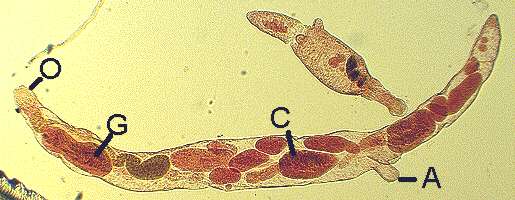Relatively few helminths multiply asexually as adults. Gyrodactylus uses serial polyembryony, in which the embryo developing within the uterus contains within itself yet another, even less-developed, embryo.

Many protozoans multiplu asexually as they enter the cyst stage. Entamoeba produces 4 or 8 nuclei (N), depending on species, but the cytoplasm does not divide until a new host is entered.

Giardia doubles its nuclei and also other structures, such as the two sets of sucking disks (S1 and S2) shown here. Again, cell division is not complete until the next host is infected.

Sporocysts of Digenea, within the molluscan host, asexually produce either generations of daughter sporocysts, or rediae, or cercariae, depending upon species. Faciola produces a geenration of rediae (arrow) within is sporocysts.

In a cross section of a snail infected by sporcysts of Plagiorchiiformes, sporocysts (S) containing cercariae (C) can be seen. Some of the host's gonad (G) is visible, but most of it has already been destroyed by the parasite. Asexual reproduction by parasites can place enormous energetic demands on the hosy.

Redia of Digenea produce either a second generation of rediae, or else cercariae, as shown in this Echinostoma. The rediae have a mouth and esophagus (O), a gut (G) and ambulatory appendages (A) which help them move through the host. Some of the cercariae (C) developing in this redia already have their tails.

Relatively few Cestoda use asexual reproduction. One of the notable exceptions is Echinococcus, which produces either a unilocular hydtid cyst (top photo) or multilocular hydat (lower photo). The cyst (Cy) is produced by the parasite and is surrounded by a capsule (Ca) produced by host tissue (H) as a defense response. The inner lining of the hydatid is a germinative epithelium (G) which can sprout numerous brood capsules and larval parasites.

